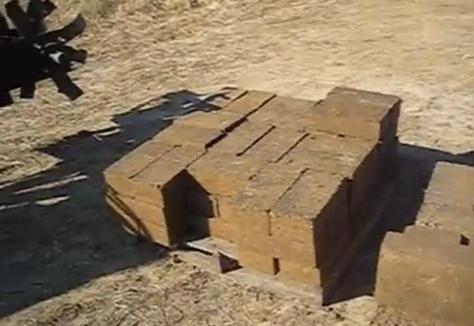Medium-fired CEB: Difference between revisions
(Created page with "This is a rather speculative idea but if workable, could potentially have very high impact. The idea is to '''fire a CEB''', thereby potentially ac...") |
(inserted images) |
||
| Line 1: | Line 1: | ||
[[File:Liberator_bricks.JPG|right|500px|thumb|''Fire them!'' (bricks pressed on [[The Liberator]])]]''' | |||
[[Image:44_cebfab.jpg |500px|thumb|Idea: fire the [[Compressed Earth Blocks|CEB]] at low to medium temperatures for (maybe) added strength and durability. ]] | |||
This is a rather speculative idea but if workable, could potentially have very high impact. The idea is to '''fire a [[Compressed Earth Blocks|CEB]]''', thereby potentially achieving some of the properties of a fired brick (water resistance, stability, etc.) but at lower temperatures. Proper fired bricks require temperatures of about 900-1000°C. They therefore have high [https://en.wikipedia.org/wiki/Embodied_energy embodied energy], even when an efficient system such as the [[Vertical Shaft Brick Kiln|VSBK]] is used. Now if a '''CEB''' is used instead of an uncompressed (i.e. “green”) brick, how would that affect the properties? And could a lower temperature achieve some of the same properties of a high-fired brick? Temperatures of about 500-600°C are available as “waste heat” from some thermal biomass uses, such as the [[biochar]] production. | This is a rather speculative idea but if workable, could potentially have very high impact. The idea is to '''fire a [[Compressed Earth Blocks|CEB]]''', thereby potentially achieving some of the properties of a fired brick (water resistance, stability, etc.) but at lower temperatures. Proper fired bricks require temperatures of about 900-1000°C. They therefore have high [https://en.wikipedia.org/wiki/Embodied_energy embodied energy], even when an efficient system such as the [[Vertical Shaft Brick Kiln|VSBK]] is used. Now if a '''CEB''' is used instead of an uncompressed (i.e. “green”) brick, how would that affect the properties? And could a lower temperature achieve some of the same properties of a high-fired brick? Temperatures of about 500-600°C are available as “waste heat” from some thermal biomass uses, such as the [[biochar]] production. | ||
A brief background search did not reveal whether this had been attempted. | A brief background search did not reveal whether this had been attempted. If possible, a system similar to the [[Vertical Shaft Brick Kiln|VSBK]] could be devised but would only have conduct the heat, and not require active firing. This would make things much simpler. | ||
==Outlines a Research Project== | ==Outlines a Research Project== | ||
* needed: [[Compressed Earth Blocks|CEBs]] (should not contain any organic matter!) | * needed: [[Compressed Earth Blocks|CEBs]] (should not contain any organic matter!) | ||
* “bake” at different temperatures, with different time courses (length of | * “bake” at different temperatures, with different time courses (length of firing). | ||
* evaluate properties of bricks | * evaluate properties of bricks (strenght, durability, etc.) | ||
* publish findings | * publish findings | ||
| Line 12: | Line 16: | ||
* [[Vertical Shaft Brick Kiln]] | * [[Vertical Shaft Brick Kiln]] | ||
* [[The Biochar Economy]] | * [[The Biochar Economy]] | ||
* [[Compressed Earth Blocks]] | |||
[[Category:Housing and construction]] | [[Category:Housing and construction]] | ||
[[Category:Materials] | [[Category:Materials]] | ||
Revision as of 19:00, 15 July 2016


This is a rather speculative idea but if workable, could potentially have very high impact. The idea is to fire a CEB, thereby potentially achieving some of the properties of a fired brick (water resistance, stability, etc.) but at lower temperatures. Proper fired bricks require temperatures of about 900-1000°C. They therefore have high embodied energy, even when an efficient system such as the VSBK is used. Now if a CEB is used instead of an uncompressed (i.e. “green”) brick, how would that affect the properties? And could a lower temperature achieve some of the same properties of a high-fired brick? Temperatures of about 500-600°C are available as “waste heat” from some thermal biomass uses, such as the biochar production.
A brief background search did not reveal whether this had been attempted. If possible, a system similar to the VSBK could be devised but would only have conduct the heat, and not require active firing. This would make things much simpler.
Outlines a Research Project
- needed: CEBs (should not contain any organic matter!)
- “bake” at different temperatures, with different time courses (length of firing).
- evaluate properties of bricks (strenght, durability, etc.)
- publish findings